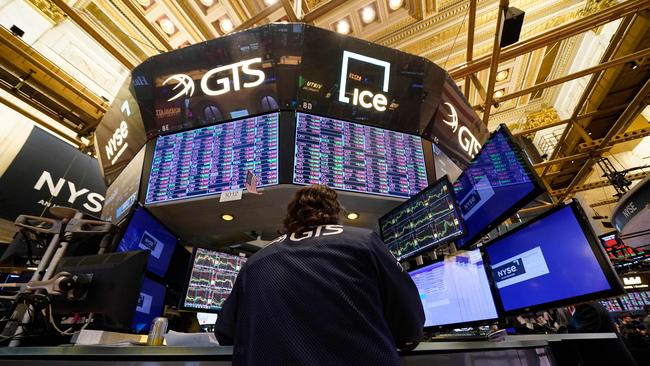Investors view corporate earnings season as next test for stocks
The heavyweight banking sector is drawing heightened scrutiny following the recent turmoil with Credit Suisse and Silicon Valley Bank.

This week’s kick-off to the corporate earnings season offers the next trial for the market as investors consider whether US stocks can hold on to recent gains in the face of deteriorating profits.
Analysts expect companies in the S&P 500 to report a second consecutive decline in quarterly earnings. First-quarter profits are projected to drop 6.8 per cent from the same period a year earlier, according to FactSet. That would mark the steepest earnings decline since the second quarter of 2020, when the onset of the Covid-19 pandemic resulted in a 32 per cent profit contraction.
“From a corporate earnings perspective, we’re already in a recession,” said Eric Gordon, head of equities at Brown Advisory.
Companies have been fighting a host of challenges, including inflation and rising interest rates — and, more recently, concern about the health of the financial system in the wake of the two biggest bank failures since the 2008 financial crisis. Yet US stocks have risen this year, with the S&P 500 up 6.9 per cent.
Although Wall Street has been trimming its earnings expectations, investors are looking to this next round of reports for insights into just how much farther corporate profits could fall and whether that makes stocks look pricey relative to their value.
Investors will review quarterly results this week from some of the country’s biggest banks, including JPMorgan Chase & Co, Citigroup and Wells Fargo & Co. Investors will also parse the latest consumer- and producer-price reports for a read on whether inflation is easing, which is likely to influence the pace of the Federal Reserve’s campaign to raise interest rates.
Friday’s monthly jobs report showed that the economy continued to add jobs at a healthy clip in March, which might increase investors’ expectations that the Fed will lift rates at its next meeting in May.
Banks will set the tone early on as the first wave of companies to report results. Investors are watching the sector with heightened scrutiny after March’s banking-system turmoil. Many market participants are looking to see if bank executives signal plans to rein in lending, which carries implications for the growth outlook across industries and could affect the Fed’s interest-rate trajectory.
“We’re trying to figure out how big of an impact tighter lending standards will have on economic growth,” said Scott Duba, chief investment officer and managing director of wealth management at Prime Capital Investment Advisors. “It’s going to tell us a lot about how loose or tight financial conditions are.” Mr Duba said his firm currently prefers shares of healthcare and consumer-staples companies, defensive stocks seen as safety plays when the market gets rocky.
Earnings reports from megacap technology companies loom large over the market after a significant run-up in share prices to start the year. The heavy weighting of such companies as Apple Inc. and Microsoft Corp. in the S&P 500 make results from them particularly influential in the direction of the overall stock market.
“It doesn’t make sense to me that tech stocks are on the upward swing while earnings expectations are lower,” said Anna Rathbun, chief investment officer at CBIZ Investment Advisory Services. “I think there’s going to be some reality check when earnings start to come out.”
A core question for investors is just how long customers can continue stomaching higher prices as companies try to pass on elevated costs. Analysts expect first-quarter revenue from S&P 500 companies to grow 1.8 per cent, which would mark the lowest sales increase since the third quarter of 2020.
Early quarterly reports show some companies are maintaining sales and profits despite the difficulties. The food company Conagra Brands reported stronger-than-expected earnings last week, citing inflation-driven price increases. Nike reported a 14 per cent jump in quarterly sales and raised its revenue growth target in March as it worked through an inventory glut.
Some investors said they have braced for weaker results based on the sharp drop in consensus estimates. Analysts marked down their earnings expectations during the first quarter by about 6.2 per cent, a much sharper revision than normal, according to FactSet. That provides companies with a lower bar to clear to give investors greater confidence to scoop up shares.
“Expectations heading into this quarter are pretty low,” said George Cipolloni, portfolio manager at Penn Mutual Asset Management. “If you do beat and you give a decent forecast, you have that potential for your stock to pop up in a short period of time.” Earnings estimates for the latter half of 2023 remain relatively rosy, which could lead to further revisions on Wall Street, according to some investors. For the year, analysts predict earnings growth of 1.2 per cent.
Falling profits run the risk of making stocks appear more expensive relative to companies’ profits moving forward. Companies in the S&P 500 are trading at about 18 times their projected earnings over the next 12 months, according to FactSet, higher than the 10-year average of 17.3.
“Earnings expectations are going to need to come down as these tighter lending standards start to flow through the economy,” said Mr Gordon of Brown Advisory.
“As we learn through the reporting season exactly how meaningful the reset needs to be on earnings, that will help dictate the directionality of equities for the remainder of the year.”
The Wall Street Journal






To join the conversation, please log in. Don't have an account? Register
Join the conversation, you are commenting as Logout